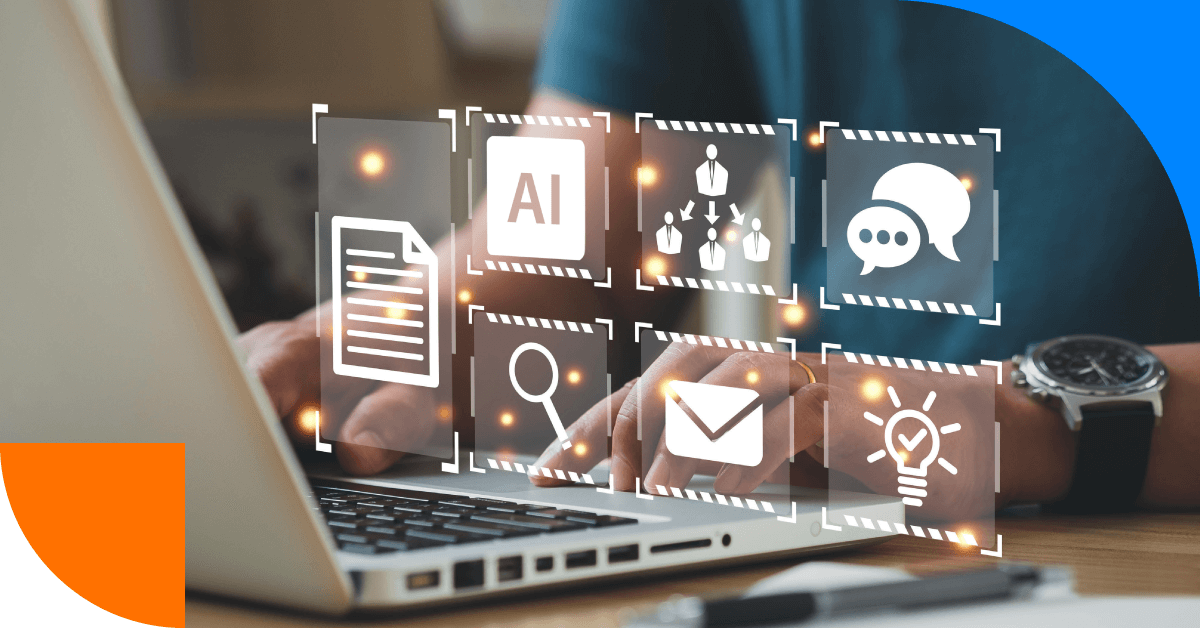Navigating the endless LMS options out there is complicated enough on its own. Add it in the extra layer of complexity that comes with choosing an enterprise LMS, and it’s enough to turn anyone away from the task.
This guide will answer the question of what an extended enterprise learning management system is, and perhaps more critically, what is the difference between a standard LMS and an elms.
The basic functionalities of a standard LMS can work well for small businesses. However, when you need to handle an extensive user base, diverse training needs, and detailed reporting requirements, an enterprise LMS is the way to go.
Let’s get into the unique features and benefits of an enterprise learning management system, how to determine if your business needs one, and the key capabilities that make it an ideal solution for your corporate training.
What is an enterprise learning management system?
An enterprise learning management system (ELMS), also referred to as an enterprise LMS, is a robust software application that delivers, tracks, reports on, and manages an organization’s training and learning.
It tackles the complexity and scale of enterprise-level training needs and surpasses the capabilities of a basic learning management system.
Key aspects that go beyond a standard learning management system are:
- Scalability
- Enhanced user and course management capabilities
- Advanced security features
- Customization
These features empower you to smoothly manage extensive user bases and diverse training needs.
What are the differences between a LMS and an enterprise LMS?
Both a standard learning management system and an enterprise learning management system deliver and manage training programs. The key differences between these two are their features, how well they scale for large numbers of learners and courses, and who the target training audience is.
Let’s explore these differences:
Features
A standard LMS offers basic functionalities like:
- Course creation
- Content delivery
- Progress tracking
If your business is small to mid-size, these features are sufficient.
In contrast, an enterprise learning management system offers advanced features like:
- Customizable reporting and analytics
- Multi-tenancy
- AI-powered course creation
- Extensive branding options
If you’ve ever been responsible for rolling out training across a large organization, then you know these advanced features quickly become a must-have.
Scalability
One of the most significant differences between a standard learning management system and an enterprise learning management system is scalability. A standard LMS may struggle to handle a large number of users and the content they require. Performance issues come up when it is overloaded.
An enterprise LMS scales effortlessly, accommodating thousands of users and managing vast amounts of content, without sacrificing performance. This scalability provides assurance that, whether the training is designed for a particular group of employees, or implemented across the whole company, everyone can access the necessary resources without facing any performance issues.
Target audience
Standard LMSs typically serve small to mid-sized businesses. These businesses have smaller employee bases, and simpler training programs.
Enterprise LMSs serve large organizations with intricate training needs. You’ll usually find they have multiple departments, diverse employee roles, and external partners and customers who also need training.
Specific needs of enterprise-level organizations
If you’re an enterprise-level organization, you likely need more than what a standard LMS can offer.
Some examples of the advanced functionality you may require include:
- Advanced analytics to gain deeper insights into training status and effectiveness:
It’s well known that large organizations are often subject to much higher scrutiny and stricter regulatory requirements than smaller ones. As a result, you’ll likely need detailed insights on time to complete compliance courses, certification status, and more.
- Customizable interfaces to align with corporate branding:
Big companies often come along with a big brand and reputation, and it’s important that they maintain a consistent identity across their content, both for internal training for employees, and external training for customers or partners.
- Robust security measures to protect data:
Enterprise-level organizations often have branches that span across different countries and continents. As a result, the LMS they use needs to stand up to various regulations, including GDPR. These businesses also have a legal and ethical responsibility to protect sensitive data, including employee personal information, as well as proprietary information, intellectual property, and competitive strategies.
Not all enterprise businesses may have all three of the above requirements (and there are certainly other requirements that go beyond these three). But if your organization has even one of these, that’s reason enough to move away from a simple LMS and consider an enterprise LMS.
6 signs your business needs an enterprise learning management system
Your training needs become more complex and demanding as your business grows and evolves. Here are some signs that you have outgrown a standard learning management system and would benefit from an enterprise online learning management system.
1. Rapid growth
If your organization is experiencing rapid growth, your current LMS may struggle to keep up. An increase in employees, new departments, or expanded operations can overwhelm your standard LMS.
The design of an enterprise LMS empowers it to scale effortlessly. It can accommodate a growing user base and content, without compromising performance. This scalability means your training program can keep pace with your business’s expansion.
2. Complex training requirements
A standard LMS handles straightforward training programs. However, as you grow, your training needs can become more complex.
For example, you may need to deliver specialized training for different departments, roles, or compliance requirements. Or, you may want to create personalized training that adapts based on employees’ answers and scores.
An enterprise learning management system offers advanced features like:
- Customizable reporting and analytics
- Multi-tenancy
- AI-powered course creation
- Learning paths
Each of these is essential for managing and delivering complex training programs.
3. Diverse user groups
A standard LMS may fall short when your training needs extend beyond internal employees to external partners, customers, or teams. An extended enterprise learning management system handles diverse user groups.
You can create your own specific attributes to categorize learners and assign them training, based on the fields that are relevant to your organization. In the event that you need separate training environments for internal vs external training, an enterprise LMS can support this from a single platform for the training manager, while appearing as distinct environments for learners.
4. Need for advanced customization
Large organizations often need extensive customization to align the training platform with their specific branding and needs. A standard LMS may offer a lower level of customization than required.
An enterprise learning management system allows for advanced customization. The platform adapts to meet your unique requirements. Some examples of these customizations include:
- Customizable themes, colors, logos, and branding
- Custom domain name
- Custom user roles and permissions
- Customizable reports and analytics dashboards
- Custom integrations with other systems
- Customizable certificates and gamification elements
5. Enhanced reporting and analytics
As training programs become more advanced, the need for detailed reporting and analytics increases. A standard LMS may provide basic tracking and reporting features. An enterprise learning management system offers more advanced reporting capabilities.
With a higher level of reporting, you can gain deeper insights into training effectiveness and make data-driven decisions to improve training outcomes.
6. Regulatory compliance
If you’re in a highly regulated business, you know the importance of maintaining industry standards. An enterprise learning management system provides the tools to ensure training programs meet compliance requirements.
Features like detail tracking, automated reporting, and audit trails are essential for avoiding legal issues and maintaining compliance. Enterprise-level LMSs allow you to extract specific data points in real-time in the event of audits or compliance reviews.
If your organization is experiencing rapid growth, it’s likely time to consider upgrading to an enterprise learning management system. This move will ensure you have robust and scalable training programs that meet your business’s evolving needs.
LMS challenges and how an enterprise LMS can help
Implementing and using a learning management system can bring significant benefits, and real challenges. Understanding these challenges can help you make informed decisions to leverage your LMS effectively.
Here are some top challenges you might face when using a standard LMS and how an enterprise LMS addresses them.
Complex implementation process
Challenge: Setting up a standard learning management system can be daunting.
The process involves:
- Configuring the system
- Migrating data
- Integrating with other software
- Training staff to use the new platform
Solution: An enterprise learning management system offers robust support and comprehensive documentation to assist in the implementation process. Dedicated customer support helps with configuration, data migration, and integration with other enterprise systems. Having support ensures a smooth and efficient setup.
User adoption and engagement
Challenge: Ensuring your staff consistently uses and engages with a standard LMS can be difficult. They might resist using the system if motivation and a user-friendly design are lacking. Low participation rates can lead to suboptimal training outcomes.
Solution: An enterprise learning management system offers an intuitive, user-friendly interface. Features like gamification, personalized learning paths, and interactive content help optimize learner engagement. Keeping learners motivated improves overall participation and training effectiveness.
Limited customization options
Challenge: Many standard LMSs offer limited customization options. Organizations that require the platform to reflect their unique branding and functional needs find this problematic. This lack of flexibility results in a less cohesive user experience.
Solution: Enterprise LMSs allow for extensive customization and branding options. You can tailor the interface to align with your specific needs.
Scalability issues
Challenge: As your organization grows, your training needs will evolve. A standard LMS may struggle to keep up. Performance issues may occur as your user base and content libraries increase.
Solution: One of the key features of an enterprise LMS is the ability to scare effortlessly. Whether expanding the user base or increasing content libraries, an enterprise LMS ensures consistency through growth.
Insufficient reporting and analytics
Challenge: When detailed insights into training effectiveness are needed, many standard LMSs fall short. Many only provide basic reporting features, making gathering the data needed to assess and enhance training programs difficult.
Solution: Enterprise learning management systems offer highly customizable reporting and analytics.
You can create tailored reports that provide deep insights into:
- Learner progress
- Courses with the highest and lowest engagement statistics
- Most challenging training topics and skill gaps
- Overall training impact
These reports help make data-driven decisions that will continuously improve the training programs.
Security concerns
Challenge: Protecting sensitive training data is essential. Ensuring robust security measures are in place can be a challenge with some standard learning management systems.
Solution: An enterprise learning management system offers robust security features like:
- Data encryption
- Secure user authentication
- Compliance with industry standards and GDPR
- 2-factor authentication
- Password strength checker
These features ensure your organization’s training data is safe from unauthorized access.
While a standard learning management system works for smaller organizations, an enterprise learning management system is more effective for larger businesses. It might be time to level up if you want to optimize your training programs as you grow.

Trainings that require an enterprise learning management system
The enterprise LMS you choose should undoubtedly cover multiple types of training in your company. Here are several training types that become significantly easier to roll out when you have an enterprise LMS in place:
Onboarding training
Effective onboarding is crucial when bringing new employees into your organization. An enterprise LMS provides comprehensive onboarding programs tailored to different roles and departments.
Features like personalized learning paths, progress tracking, and interactive content allow new hires to get up to speed and become productive team members quickly.
Compliance training
Compliance training is critical for ensuring your employees adhere to regulations and policies. An enterprise LMS provides robust tools to manage and deliver compliance training efficiently.
It offers detailed tracking and reporting capabilities to monitor completion rates and ensure everyone meets mandatory training requirements. This helps organizations avoid legal issues and maintain compliance.
Extended enterprise training
As your business grows, you may need to train external partners, customers, and teams. Using a standard LMS can prove difficult.
An extended enterprise LMS handles these diverse user groups. It allows organizations to deliver consistent training across different audiences, ensuring everyone is knowledgeable about products, services, and best practices. This type of training can improve partner performance and enhance customer satisfaction.
Customer training
Customers need the right training to benefit fully from your product or service. An enterprise learning management system meets this need. By providing accessible, engaging, and targeted training for different customer segments, they get the most out of your offerings.
Training helps your organization save on support costs, improve customer satisfaction, and increase brand loyalty.
Key features to look for in an enterprise learning management system
Choosing the right enterprise learning management system is crucial for large organizations with complex training needs.
Here are some essential features to look for in the best enterprise learning management system:
Customizable reporting and analytics
You need customizable reporting and analytics to truly understand and enhance your training programs. Advanced reporting capabilities allow you to create tailored reports based on specific needs. Detailed analytics help identify trends, measure training effectiveness, and make data-driven decisions for future improvements.
Advanced customization
An enterprise learning management system should provide advanced customization that allows you to tailor the platform’s look and feel, as well as user roles and learning paths. The functionality is there to meet your specific goals.
A seamless, branded learning experience enhances user engagement and reinforces your organization’s identity.
Multi-tenancy
Multi-tenancy is a critical feature for organizations that need to manage multiple learning environments within a single LMS. This feature ensures that each group—departments, subsidiaries, or external partners—can access customized training content and resources while being managed centrally. This ability leads to a more efficient and organized training management process.
AI-powered course creation
Having AI-powered course creation in your learning content management system is quickly transitioning from a nice to have, to a must have for enterprise companies.
An enterprise LMS with AI-powered course creation tools can dramatically reduce the time it takes to get your courses up and running. This feature takes the heavy lifting out of creating resources like process guides, images, and assessments.
With these advanced features, your training programs become more efficient and effective. Your LMS can now meet enterprise-level training initiatives’ complex and evolving needs.
FAQs
- What is the purpose of an enterprise learning management system (elms)?
An enterprise learning management system (ELMS) is a software platform designed to deliver, administer, track, and manage organizational training programs. - How does an enterprise learning management system improve employee engagement?
An enterprise learning management system boosts employee engagement by offering personalized learning paths and flexible access to training materials anytime and anywhere.
Interactive content such as gamification, videos, and quizzes makes learning enjoyable, while social learning tools foster community and knowledge sharing. Employees can track their progress and receive recognition, motivating continued participation. These features collectively promote a culture of continuous learning and engagement. - How do you choose an enterprise learning management system?
The process of choosing an elms will vary from one business to another, but there are some universal factors to consider. Ease of use, scalability, integration capabilities with existing systems, cost, and alignment with specific organizational learning needs are all important.
The strategic advantage of an enterprise learning management system
An enterprise learning management system is essential for any large organization aiming to stay competitive and agile in today’s fast-paced business environment. Its advanced features aren’t merely enhancements—they’re necessities.
Investing in the best enterprise LMS empowers your workforce, drives organizational success, and supports sustainable growth. You’re not just improving training management, but committing to your organization’s future excellence.
Key takeaways
- An enterprise LMS effortlessly scales to accommodate growing user bases and diverse training needs, ensuring consistent performance as your organization expands.
- Customizable reporting and analytics, multi-tenancy, and AI-powered course creation are essential for managing complex training programs in large organizations.
- Extensive customization options allow the LMS to align with your organization’s unique branding and functional requirements, enhancing user engagement.
- An enterprise LMS provides the necessary tools for detailed tracking, automated reporting, and audit trails to meet stringent regulatory requirements and avoid legal issues.
- By offering personalized learning paths, interactive content, and social learning features, an enterprise LMS significantly boosts employee engagement and promotes a culture of continuous learning.



